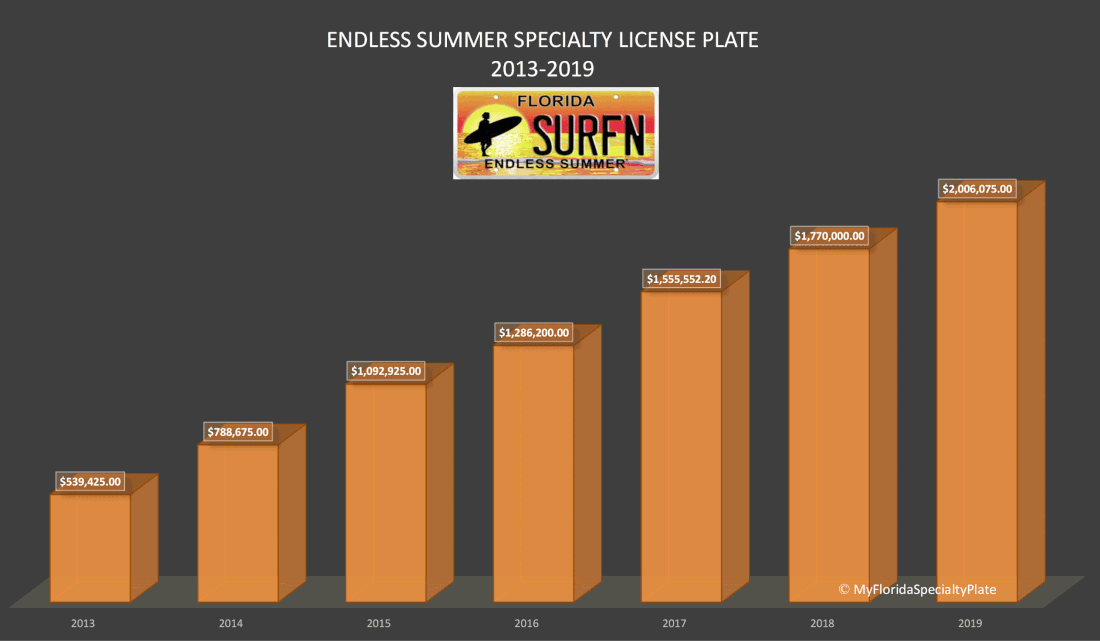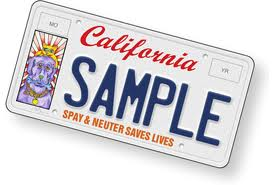 James Bond had a license to kill, but apparently he also wanted his very own license plate. Pierce Brosnan is well-known for his portrayal of James Bond in four films between 1995 and 2002, but most fans are less aware that he once designed a license plate for the state of California. In 2010, Brosnan and his wife Keely were among several people who co-founded the California Spay and Neuter License Plate Fund, with the goal of raising money to sponsor low- or no-cost procedures for pets from low-income families. A few years later, the fund worked with the California Department of Motor Vehicles to offer motorists the opportunity to purchase a special “Pet Lovers” license plate, with funds going toward the cause. While the majority of the plate’s color scheme is based on the standard California design, it also features the image of a purple dog and a cat in sunglasses — which is original artwork by Pierce Brosnan, depicting his adopted dog Shilo and his adopted cat Angel Baby. The fees collected from ordering the Pet Lover’s license plate are still awarded annually to facilities all over California. The money is first sent to the California Department of Food and Agriculture, to be then awarded on a grant basis to animal control units or nonprofit shelters that offer spay and neutering services. In 2021, for instance, the program awarded $330,000 across eight projects to help stop pet overpopulation. This year, there is up to $488,000 available in funding. The pet lover’s license plate can still be requested at California DMV locations and ordered online
0 Comments
Proposition 15: Increases Funding for Public Schools, Community Colleges, and Local Government Services by Changing Tax Assessment of Commercial and Industrial Property. Initiative Constitutional Amendment. Yes/No Statement A YES vote on this measure means: Property taxes on most commercial properties worth more than $3 million would go up in order to provide new funding to local governments and schools. A NO vote on this measure means: Property taxes on commercial properties would stay the same. Local governments and schools would not get new funding.  Dr. Priscilla Chan and Mark Zuckerberg Dr. Priscilla Chan and Mark Zuckerberg The Legislative analysis states that increased property taxes on commercial properties worth more than $3 million will provide $6.5 billion to $11.5 billion in new funding to local governments and schools. 60% would go to cities, counties, and special districts. Each city, county, or special district’s share of the money depends on several things including the amount of new taxes paid by commercial properties in that community. Not all governments would be guaranteed new money. Some in rural areas may end up losing money because of lower taxes on business equipment. The other 40% would increase funding for schools and community colleges. Each school or community college’s share of the money is mostly based on how many students they have. ‘Property’ Includes Land, Buildings, Machinery, and Equipment. The measure requires commercial and industrial (after this referred to simply as “commercial”) land and buildings to be taxed based on how much they could be sold for instead of their original purchase price. This change is put in place over time starting in 2022. The change does not start before 2025 for properties used by California businesses that meet certain rules and have 50 or fewer employees. Housing and agricultural land continues to be taxed based on its original purchase price. The measure reduces the taxable value of each business’s equipment by $500,000 starting in 2024. Businesses with less than $500,000 of equipment pay no taxes on those items. All property taxes on business equipment are eliminated for California businesses that meet certain rules and have 50 or fewer employees. The Chan Zuckerberg Initiative (CZI) was founded by Dr. Priscilla Chan and Mark Zuckerberg in 2015, and according to the website, is a new kind of philanthropy that’s leveraging technology to help solve some of the world’s toughest challenges — from eradicating disease, to improving education, to reforming the criminal justice system. To date, CZI has granted $1.805 million to the campaign and is contributing an additional $4.5 million, bringing total support for the measure to just over $6.3 million. CZI is also granting $1 million to the No on Proposition 20 campaign to oppose a measure that would incarcerate more people for low-level crimes and increase already bloated prison budgets. “For generations, there has been profound inequity in the way we resource local services — with disinvestment over time and an increasingly limited ability for local communities to address their most pressing needs,” said Michael Troncoso, Head of Justice & Opportunity at CZI. “Even before COVID-19, Black and Brown communities have lacked the resources needed to sustain adequate local health care systems, protect essential workers, and support our schools. This systematic disinvestment was built into the law, and we now have the historic opportunity, through Proposition 15, to correct it and get our communities the support they need.” Campaign Finance Reports from the Secretary of State show the payments made by CZI.
Surfing advocates and California’s Coastal Commission rained ire this week on a bill that would allow San Diego and Orange county homeowners to build seawalls by right, sidestepping commission oversight. Seawalls are highly controversial in California, viewed as a property defense against sea-level rise and the crumbling of coastal cliffs. At the same time, seawalls prevent the natural replenishment of beach sand from cliff faces and land runoff. Republican Sen. Pat Bates, who represents portions of San Diego and Orange counties, brought SB 1090 before the Senate Natural Resources and Water Committee allowing testimony from pre-selected speakers. The father of an Encinitas family that lost three members when a cliff collapsed on top of their weekend picnic last year gave emotional testimony on behalf of the bill. “There is no plan for sand replenishment or any other bluff changes to increase safety on this very popular stretch of beach where my accident occurred,” said J. Patrick Davis, a pediatric dentist. Seawalls, or “hard armoring” as Surfrider Foundation’s scientist Jennifer Savage called the structures, do not make beaches safer, she said. “They destroy the beach by speeding-up erosion,” Savage said. 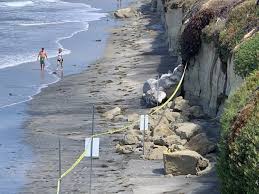 The Coastal Commission representative argued the Encinitas incident was a tragic accident, not due to a lack of action by the commission to approve or deny a seawall in the area. “The bill is designed to make it faster, easier and cheaper to build seawalls primarily to protect private residential development,” Sarah Christie, the commission’s legislative director, testified. “For every seawall that is built, the public loses a beach.” There was no committee vote, however. Sen. Henry Stern, the committee chair, and Bates agreed ahead of time to hear the bill without the vote, and testimony was heard on May 26, 2020. said Josh Kirmsse, Stern’s communications director. The Committee Analysis states that for Orange and San Diego Counties, this bill would effectively authorize by-right construction of sea walls/other hard shoreline structures and only allow the commission or a local government to deny an application for a shoreline protective device only if they determine that the construction of a shoreline protective device would constitute a substantial threat to the public health or safety. It also seeks to prohibit a state agency or local government to adopt an ordinance, regulation, policy or rule that is inconsistent with these requirements. Supporters of the bill include California Apartment Association, California Association of Realtors, Newport Beach Association of Realtors, North San Diego County Association of Realtors, Oceanside Chamber of Commerce, Orange County Realtors, County of San Diego, and ‘four individuals’. 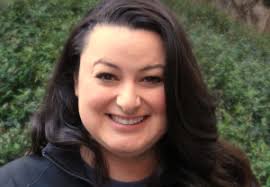 Marce Gutierrez-Graudins Marce Gutierrez-Graudins Opposers to the bill included Azul. Azul was founded in 2011 by Marce Gutierrez-Graudins, to bring Latinxs perspectives and participation to ocean conservation, and are legally organized under the Trust for Conservation Innovation. After experiencing how mainstream ocean conservation efforts and campaigns were leaving Latinxs out, Marce decided to start Azul to engage her community in protecting coastal resources and marine life. In a joint sign-on letter expressing strong opposition, Azul, among others, writes that SB 1090 “would pave the way for private property owners to effectively hasten and accelerate the loss of public beaches from the Orange County and San Diego coasts under the guise of claiming to improve public safety.” Others who registered in opposition to the bill were California Coastal Protection Network, Heal the Bay, California Coastal Commission, California Coastkeeper Alliance, California League of Conservation Voters, California Native Plant Society, Center for Biological Diversity, Clean Water Action, Defenders of Wildlife, Natural Resources Defense Council, Plastic Pollution Coalition, Seventh Generation Advisors, Sierra Club California, Surfrider Foundation, The 5 Gyres Institute, The Center for Oceanic Awareness, Research, and Education (COARE), The Honorable Betty T. Yee, California State Controller, and the Nature Conservancy. Senators will do more work on the legislation at the committee level. The bill analysis also states that erosion will be exacerbated by the presence of sea walls on the seaward size of the sea wall. Public accessibility will be correspondingly compromised. Beaches need natural erosion and sediment transfer for their health. Living shorelines, soft armoring and managed retreat, if necessary, should be prioritized. How can shoreline armoring be “designed to mitigate or protect against coastal erosion” as it is known to exacerbate that very thing? It also comments that the bill provides an implicit public subsidy to private landowners.
Click here for the full bill text. Lawsuit Aims To End California License Plate Language Restrictions - Michael Towner, Iconic Legacy8/1/2020 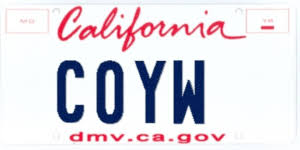 California may have to end most restrictions on personalized license plate language that some might find offensive, if a lawsuit filed Tuesday prevails. The libertarian Pacific Legal Foundation lawsuit challenges the state Department of Motor Vehicles' current policy on free speech grounds. The department denied more than 30,000 of the nearly 250,000 applications submitted in 2018, the last year for which statistics are available, after deciding that the proposed language “may carry connotations offensive to good taste and decency," says the lawsuit filed in federal court in San Francisco. “This broad and vague regulation requires four full-time DMV administrators police license plate applications," the lawsuit argues. Those denials “deprive plaintiffs their right to freedom of speech, in violation of the First Amendment to the United States Constitution." Department officials did not immediately respond to telephone and email requests for comment. The program brings the state more than $60 million each year. The environmental plates challenged in the lawsuit cost $53 initially and $43 annually to renew and are among 14 special interest license plates that help pay for environmental and special programs. The lawsuit comes months after another federal judge rejected the department's argument that vehicle license plates constitute government statements, ruling that it is unlikely that “viewers perceive the government as speaking through personalized vanity plates.” In that challenge filed by the same nonprofit legal organization, the department subsequently allowed California soccer fan Jonathan Kotler to honor his favorite team with the vanity plate “COYW.” Kotler supports London-based Fulham, whose fans often chant “Come On You Whites” for their players in white jerseys. “Upon further administrative review, the DMV determined Mr. Kotler's personalized plate request for ‘COYW' should not have been rejected and is expediting the approval to get it to Mr. Kotler as quickly as possible,” Anita Gore, a deputy director with the DMV, wrote in an email on Tuesday. The DMV had previously told Kotler “COYW” has “connotations offensive to good taste and decency.” But the department didn't change its underlying policy, which the new lawsuit seeks to end on the grounds that the First Amendment doesn't allow the government to ban speech just because it finds it offensive. “We probably wouldn't challenge a regulation limited to seven obscene words, but it strains credulity to say that there are over 30,000 messages per year, ranging from sports cheers (COYW) to someone's nickname (OGWOOLF) that need to be banned," foundation attorney Wen Fa said in an email exchange. “As the DMV's regulation underscores, vague bans on ‘offensive' speech inevitably lead to arbitrary results.” The OGWOOLF plate was sought by the firm's lead plaintiff in the new lawsuit, Army veteran Paul “Chris” Ogilvie of Concord, California. He says it combines the first two letters of his last name with an old nickname. The department rejected the plate for fear people would interpret OG as short for “original gangster,” the lawsuit says. It says he acquired the nickname OG during his military service. The firm probably has a good point, said Eugene Volokh, who teaches First Amendment law at the the UCLA School of Law. "When the government sets up a program in which people can engage in their own speech, like a license plate program, it generally has to administer it in a reasonable and viewpoint-neutral way, so it doesn't discriminate based on viewpoint,” he said. The current policy seems to fall short, he said, “first of all because that's very vague and separately because some of the offensiveness that the DMV seems to be pointing to seems to come from the viewpoint.” The suit includes plaintiffs with four other examples:
- “DUK N A,” which the lawsuit says is short for Ducati motorcycles and Andrea, the first name of plaintiff Andrea Campanile. The department said it sounds like an obscene phrase. - “BO11UX,” though the lawsuit says “bullocks” has been used to mean “nonsense” in a national advertising campaign. - “SLAAYRR,” which it says is a reference to the metal band - “QUEER,” which it says is a reference to the plaintiff's sexual orientation and his record label, Queer Folks Records, which he adopted in an effort to reclaim what has become a pejorative label. Even if the state ultimately allows more arguably offensive words on license plates, Volokh said, "it's not such a huge deal. It's not that people will start distrusting the DMV. Anything people can say on a license plate they could say on a bumper sticker.”  Lynsi Snyder, pictured with fourth husband Sean Ellingson earlier this year. Photo / Getty Images Lynsi Snyder, pictured with fourth husband Sean Ellingson earlier this year. Photo / Getty Images Notoriously private billionaire CEO Lynsi Snyder appeared on the 2019 Wealthiest Angelenos List, published by the Los Angeles Business Journal, at number 27, with a net worth of $2.9 billion, well above Shawn ‘Jay-Z’ Carter and Beyonce Knowles-Carter who were tied with Aubrey Chernick at number 49 with $1.5 billion. Aubrey Chernick grew up in Deloraine, a small town of 900 people in the Canadian province of Manitoba where his father owned a small store (“Thrifty Stores”). Chernick started his own software company to build software that would manage a new IBM Operating System. He called his company Candle Corporation. IBM itself became a customer of Candle when IBM had difficulty in understanding how their own computers worked. In 2015, Chernick launched NextGen Crowdfunding, as the go-to place on the Web where they can educate themselves on the latest application of these critical fund-raising programs.  Evan Spiegel and Miranda Kerr Evan Spiegel and Miranda Kerr Elon Musk topped the list at a net worth of $22.6 billion. Evan Spiegel, co-founder and CEO of the American social media company Snap Inc., (Snapchat) which he created with Bobby Murphy and Reggie Brown while they were students at Stanford University, is now ranked at 19, with a net worth of $3.7 billion. Spiegel was named the youngest billionaire in the world in 2015. He is now 30 and married to Miranda Kerr, a former Victoria’s Secret Angel Lynsi Snyder spoke about her troubled life and her unexpected side job during a very rare media interview. The 37-year-old is the heiress to the In-N-Out burger chain fortune, with a net worth of around $3.6 billion in 2020, according to Forbes. The beloved US fast food chain was founded by her grandparents Harry and Esther Snyder in California in 1948. Due to a series of family tragedies, Ms Snyder became the family's last remaining heir in 2000 when she was just 18, after the deaths of her father and uncle. Her father Guy Snyder died of an overdose in 1999, when she was just 17. Her uncle Richard Snyder had died in 1993 in a plane crash along with In-N-Out executive vice president Philip R West. She said her parents had divorced when she was 12, after the drugs and "another woman" impacted on the marriage. She began gradually receiving stakes in the business as part of a complicated trust plan made by her grandparents, and in 2017 she received the last slice of her fortune, on her 35th birthday.
She took over as president of the company in 2010, but despite being one of America's richest — and youngest — people, Ms Snyder had long shunned the spotlight in favor of a more reclusive life. The mother of four — who has been married four times — told The Christian Post she previously battled drug and alcohol abuse before turning her life around due to her faith. She also spoke about her side job as a Christian minister, after founding the Army of Love ministry during a particularly "painful" period of her life. "That's when I really started longing for that attention and that love, because my dad was the greatest source of that," she said. "I was calling out to God as my third marriage was failing. I was in a place where I felt I couldn't do ministry because my own heart and home were a mess," she told the Christian Post. "My (ex) husband and I were in constant turmoil. I became desperate for the hope that I could be used by God despite my circumstances." She ended up studying discipleship online and filed for a non-profit tax-exemption. As she waited for it to be approved, she ended up meeting her current husband Sean Ellingson, and the filing was approved shortly after the pair tied the knot. Ms Snyder said she was also a believer in "servant leadership" — a leadership philosophy where the leader's main goal is to serve others rather than grow the business. She said she worked hard as In-N-Out CEO to "maintain" the business without "compromising the quality of product, service, or standards." "My grandparents set the bar high and I only try to raise it," she said. With just a few days remaining until the June 15 constitutional deadline for enacting a 2020-21 budget, Gov. Gavin Newsom and his fellow Democrats in the Legislature are engaged in a debate over closing a deficit that Newsom pegs at $54 billion. It is essentially a conflict over how much direct relief, if any, California can expect from President Donald Trump and Congress to cover about $15 billion of the deficit that would remain after other actions have been taken. Newsom had proposed a $222 billion budget in January and then discarded it after the pandemic struck. He ordered a widespread shutdown affecting economic and personal behavior to deal with it, thus triggering a recession that erased millions of jobs in just a few weeks. In May, Newsom proposed a revision to his budget proposal that would cut spending to $202 billion and cover the remainder of the gap with some new revenues, some borrowing and some accounting maneuvers. He said $15 billion in cuts, mostly to K-12 education and colleges, would be automatically restored if the state received the federal aid that a $1 trillion House-passed relief bill promised. Clearly, he intended that cutting the most popular segments of the budget would help spur federal action. It was, however, too much for legislators to digest as they were hit with pleas from hundreds of advocates for services targeted in Newsom’s budget. Of course, there is the other option — raising taxes. In fact, tax increases of some kind have been used in every major budget crisis of the past half-century. The Senate’s Democratic leaders proposed, and the Assembly’s leadership later supported, a 180-degree shift from Newsom’s proposal. It would essentially retain the spending he cut on the assumption that the Federal Government will cough up the additional relief, and make reductions in the fall if the money does not materialize. So despite lots of common ground on the upcoming budget, some key disagreements have surfaced as legislative leaders and Gov. Gavin Newsom hammer out a final deal in advance of a June 15 deadline. What is different this time: The two sides are negotiating amid a bleak economic scenario, with surging unemployment, greater demand for government services and a deficit that could be as large as $54 billion. And that, undoubtedly, amps up the stress in their private debates. The fault lines this year show the Legislature and governor at odds over how to manage spending on the coronavirus pandemic, how far the state should go to help undocumented immigrants, and how much to cut schools and safety net programs if the federal government does not come through with additional aid. While Newsom proposed slashing $14 billion from schools, health care and safety net programs unless the federal government sends funds by July 1, the Legislature’s proposal assumes federal funding will arrive — and if it doesn’t come by Oct. 1, limits cuts to $7 billion by drawing on reserves. Another schism arose over how much the state should spend to help undocumented immigrants, with lawmakers wanting to go further than Newsom does in extending health care and tax breaks. Newsom will likely be in the role of saying “no” to a bunch of legislators who are unaccustomed to governing during a recession. “The definition of good legislation is a compromise that is mutually repugnant to all sides,” said political analyst Sherry Bebitch Jeffe. “And that’s what has to happen.” The only certainties are that a budget deal of some kind will be made by June 15, to protect legislators from losing their salaries, and that whatever they enact will be changed repeatedly over the next year as circumstances evolve. The only certainties are that a budget deal of some kind will be made by June 15, to protect legislators from losing their salaries, and that whatever they enact will be changed repeatedly over the next year as circumstances evolve. Schools As for the schools reopening in the fall of 2020, expect students in face masks at all times; temperature checks at the school entrance and a mix of in-class and online learning. These are just some of the new protective guidelines released on June 8, to more than 10,000 public schools across California as they plan for a much different reopening in the fall. State Superintendent of Public Instruction Tony Thurmond described the 62-page document as a checklist for schools to consider, however, the recommendations illustrate a number of drastic changes that will need to be made in order for students to return to their classrooms while practicing social distancing. “We know this is just the beginning,” he said. School districts are planning for the new school year under the financial stress of steep proposed cuts in state funding, which Thurmond and a group of education advocates have said would hamper schools’ ability to reopen if federal assistance doesn’t arrive to cushion the blow. Using state examples, here’s what a school day might look like from start to end: - A student riding the bus to school would wait at their bus stop already equipped with a face covering. Once the bus arrives, there would be seating meant to reduce capacity – one option the guidance suggests is a “zigzag pattern” in which seating by row would be limited to one student on alternating sides. - Either on the bus or as they enter campus, the student would have their temperature screened with no-touch thermometers while answering questions from staff about whether they experienced any COVID-19 symptoms, and if anyone in their home has tested positive or has shown symptoms. - The student would be in class with a smaller group of classmates. Desks would be spaced six feet apart or more. Teachers too would wear face coverings. - Everyone handwashes frequently. - During recess, schools might consider increasing supervision to make sure students are practicing social distancing. To avoid crowded cafeterias, the student would either eat their lunch in class or with their group of classmates under staggered lunch times. - Throughout the day, employees would clean and disinfect areas across campus. Perhaps the most extreme measure, the state’s guidance anticipates schools would adopt hybrid schedules. That means students either attend school on select days of the week, or most weekdays under staggered start times and shorter hours. Hybrid scheduling, Thurmond said, would help schools reduce their classroom sizes while accommodate parents who want to keep their children home under distance learning. “Many of our districts have surveyed their parents and have said that they would like to have the option for distance learning,” Thurmond said. The state’s guidance also urges schools to consider plans for if and when campuses would have to temporarily close in the fall due to local outbreaks. Choke Holds/Carotid Holds California's Assembly speaker and other key lawmakers have backed making it illegal statewide for police to use a type of neck hold that blocks the flow of blood to the brain, a proposal that appears to go beyond any other state. Major law enforcement groups did not immediately say if they would oppose the move, which comes after a different restraint used by Minneapolis police was blamed for the death of George Floyd, triggering ongoing nationwide protests. However, the Los Angeles Police Department announced an immediate moratorium on the training and use of the hold until the civilian Board of Police Commissioners can review the issue. Police departments in suburban Pasadena and El Monte and in Santa Ana in Orange County also have suspended use of the technique. Assembly Speaker Anthony Rendon endorsed legislation that fellow Democratic Assemblyman Mike Gipson said he will amend to make it illegal to use chokeholds and a carotid artery restraint tactic to forcibly detain a suspect. Officers would still have a variety of tools to control suspects if the hold is banned, ranging from voice commands to night sticks, Tasers, pepper spray and firearms. Sen. Maria Elena Durazo, a bill co-author, said 23 California law enforcement agencies have already limited its use, several in the last week. On Friday, San Jose Police Chief Eddie Garcia said his department still allows the carotid hold as a last option before lethal force. On Monday he said in a statement that his department already bans chokeholds — which he said are distinct from carotid holds. Chokeholds apply pressure from the front and stop the individual from breathing, while carotid holds are from the side. Regardless of the outcome of the budget negotiations, and the end of the George Floyd demonstrations, we now enter the fire season amidst a pandemic. While opportunities abound for a few, the many will indeed continue to suffer.
As someone said recently - "2020? I want to tell 2020 that I've had enough, I want to get off and I'll walk from here." California to get $247M refund as masks face delivery delay - Michael Towner, Iconic Legacy5/6/2020 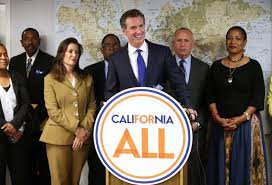 California will be refunded $247 million it paid to a Chinese company under a major deal for protective masks after the company failed to meet a deadline for federal certification of the masks, Gov. Gavin Newsom’s administration said. Newsom announced the contract last month to fanfare, saying California had inked a nearly $1 billion deal for 200 million protective masks per month amid the coronavirus pandemic. Most were set to be tight-fitting N-95 respirator masks, while the rest would be looser-fitting surgical masks. Millions of the surgical masks already arrived, but the company missed an April 30 deadline outlined in the contract for certification of the N95 masks by the National Institute for Occupational Safety and Health. The respirator masks were set to start arriving this month, with tens of millions planned for shipment in May. The governor's office provided no details on what caused the certification delay. The $247 million is half of an up-front payment the state made for the contract in April in an unusual move of making a payment before goods were delivered. The state could have clawed back all of its up-front payment under the original agreement, but an amendment signed Wednesday gives the company another month to meet the certification. If the masks are not certified by May 31, California can get the rest of the payment back in early June. The state paid $3.30 per N95 and 55 cents per surgical mask under the contract. The state made a separate $104.7 million payment last week for the delivery of the surgical masks. While the state initially sought 100 million surgical masks through the deal, it now plans to buy even more, according to the amendment, though it did not include a specific number. The state and BYD must set an updated delivery schedule for the surgical masks by Friday. A new payment and delivery schedule for the N95 masks must be set by May 22. Under the federal certification process, the final validation step would take place in Utah, Newsom said previously. It wasn't clear where the delay in the federal certification process occurred or whether the masks had yet arrived in the United States. While the masks will be made in China, the contract requires the company to comply with various U.S. and California environmental and labor laws. This isn't the first time California wired money that was then returned for masks. In March, California wired nearly half a billion dollars to Blue Flame Medical LLC for 100 million masks, but canceled the deal and got its money back later that day, CalMatters reported on Wednesday. Separately, the state was refunded $8.7 million less than two weeks after wiring the amount to a company with a Florida address, Hichens Harrison Capital Partners, according to documents from the treasurer's office. The company, which has a subsidiary in Brazil and business with China, currently advertises an "exclusive line of ventilators" on its website. In an April 13 email to California officials, Peter Leite, the president of Hichens Harrison Capital Partners, wrote the order was canceled and the money would be returned. Leite referred questions about the canceled transaction to the state on Wednesday. Spokesman for the governor's office and the Office of Emergency Services didn't immediately answer questions about the transaction. Sales of the Florida Endless Summer specialty license plate have grown 272% since 2013, now surpassing $2 million in 2019 and is now the second most popular specialty license plate out of 122 specialty plates in Florida. Funds are used for programs which include educating the general public regarding the history of surfing as a sport and as a recreational activity; providing support for lifeguards at high risk beaches to aid in the protection of the public who utilize such beaches; providing support for environmentally friendly activities; providing educational programs, including publication of articles and hosting and supporting forums and events; and for developing and supporting activities designed to assist in preserving and protecting the shoreline and the delicate ecosystems residing therein. The Endless Summer slogan is used under license from Bruce Brown Films, LLC.
Prior to 1964, the media saw surfers as rebellious thugs, and Hollywood made them out to be a bunch of idiots. Filmmaker Bruce Brown single-handedly changed that with The Endless Summer. It portrayed the wave as a kind of Holy Grail and surfers as knights on a quest. In one stroke, he replaced Hollywood’s buffoonery with the popular mythology that endures today. The Endless Summer was Brown’s sixth surfing film in a career that started almost accidentally and proceeded according to the guerrilla template of the times — shoot all winter, edit in the spring, run your ass off all summer showing the damn thing (including doing your own live narration) in school auditoriums and small halls, then pack up for another winter on the road and do it all over again. With The Endless Summer, Brown broke that mold. The "Steve Jobs loophole" for California Temporary License Plates - Michael Towner, Iconic Legacy1/31/2020 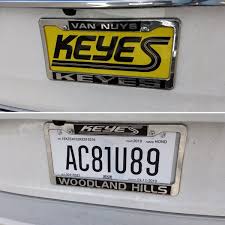 California did not issue temporary license plates for new vehicle purchases until 2019. Prior to 2019, California was unusual among the U.S. states in not requiring any form of temporary license plate. Vehicle dealers were still required to electronically report sales of new vehicles to the DMV, but they were only required to print out a DMV report-of-sale form at the time of sale. Newly purchased vehicles typically drove around for a month or more with nothing but a dealer's advertisement or logo on a paper plate insert where the license plate would go, and the DMV report-of-sale form was instead taped to the windshield. This made the new vehicle essentially "untraceable" both by plain visual observation by persons, and by automated means such as license-plate reading systems, red light cameras, and automatic number plate recognition.  This led to an epidemic of drivers of newly purchased vehicles cheating tolls on bridges and toll roads where a transponder system is used instead of toll booths, causing the state to lose $15–19 million per year. Because of this, new state legislation was adopted in 2016 requiring temporary license plates in California beginning in 2019. The DMV's reporting system was modified so that dealers could print out the temporary license plates on special paper. The law was inspired by the hit-and-run death of a pedestrian who was struck by a car with dealer paper inserts, and because it had no temporary plates it was impossible to trace the suspect. California's previous lack of a temporary plate requirement was jokingly known as the "Steve Jobs loophole" due to the one-time Apple CEO's habit of keeping rolling six-month leases on a series of Mercedes-Benz SL55 AMGs specifically to avoid having to put license plates on the cars. California's previous lack of temporary plates was also taken advantage of by criminals, who knew that a car driving with a dealer ad paper insert was both untraceable and did not raise suspicion.  As of December 31, 2019, the California Legacy specialty license plate is now on 820,426 California registered vehicles and raised $26,886,737.00 in 2019. This is up from 669,083 in December, 2018. The Kids plate is the closest by volume, which is now at 104,969, down from 107,721 in 2018 and raised over $3 million in 2019. The Whale Tail specialty license plate is now at 76,765, down from 79,934 in 2018, and raised $5,086,534 in 2019. The Arts specialty license plate is now at 48,270 (down from 50,485 in 2018) and raised $3,182,981.00 in 2019. There are 13 California specialty license plates. 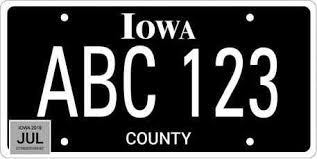 92,000 Iowa Blackout plates have been issued since they were introduced on July 1st of 2019. That's triple the number of University of Iowa plates, which was previously the most popular specialty plate. Paul Cornelius with the Iowa Department of Transportation says the agency had no idea the blackout plates would be so wildly popular. "The way that this has grown so fast and been so successful, ya, it's been kind of eye opening and shocking," said Cornelius. By comparison, there are just over 30,000 University of Iowa specialty plates currently in use. Those plates have been in existence since 1989. There are roughly 19,400 Iowa State University plates in use, which is the third most popular in the state. The blackout plates are also among the most expensive specialty plates in Iowa. They cost $30.00, and spike to $60.00 if they're personalized. Iowa and Iowa State plates sell for $25.00 and jump to $50.00 if personalized. Revenue generated from specialized license plates flows into the "road use tax fund", which is used for repairs and infrastructure upgrades. Cornelius says money from the blackout plates, which generated roughly $4 million in their first six months, will help at a time of need for the fund. "You know how bad the flooding has been this year," Cornelius said. "There's just a lot of repairs that have to have been done from a lot of that stuff. This fund, it's kind of like that's a big pot that it goes to." Still, 94% of all license plates issued in the state are the standard county plates. $932 million is generated from vehicle registration fees, of which license plates are a small portion. In six months, the 'Blackout' plate has already raised nearly twice as much as the 2019 top selling plate in Florida, where there are nearly double the amount of registered vehicles. |
BLOGArchives
January 2025
Categories
All
|

